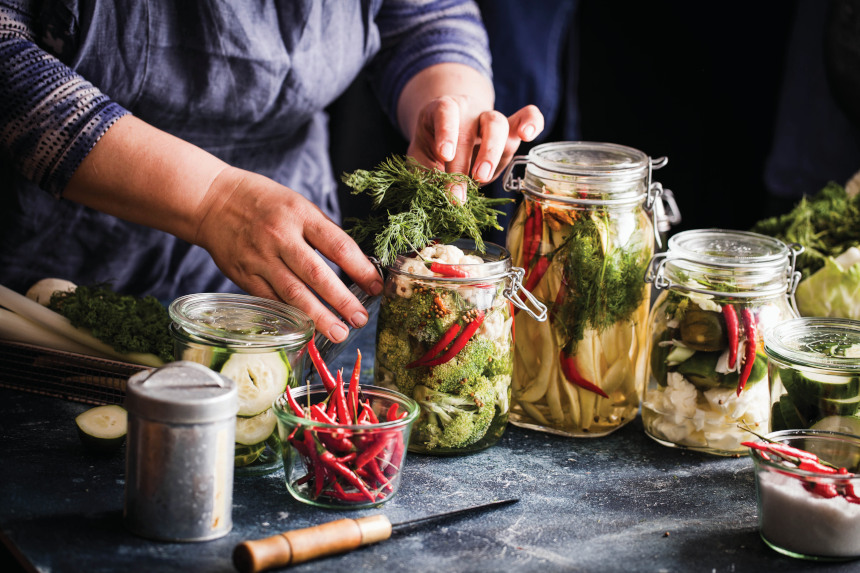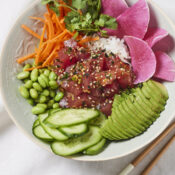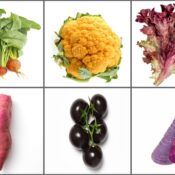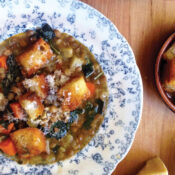My house stinks these days. You read that right: It stinks.
But it’s a good stink. A delightful stink of vinegars and herbs and spices — garlic, dill, cumin, cardamom, caraway — the olfactory evidence of my new passion: pickling.
Well, not exactly a new passion. When I was a kid, I would drop by the local deli, where fat green-and-yellow kosher pickles bobbed in a wooden barrel filled with vinegar and spice brine. I would stick my nose into the barrel and sniff the brine, then fish a promising pickle out with tongs, put it in a wax paper bag, and carry it away to eat over an afternoon. All grown up, I like pickles on my burger, pickles on the side, kimchee, baby gherkins, pickled carrots, bread and butter pickles, and the pickled ginger (gari) served with sushi. That’s the short list. I’m definitely a sour-not-sweet guy, taste buds-wise at least.
But doing the pickling myself? I suppose I was too busy trying other things. The epiphany came about a year ago when I was watching a PBS cooking show and they did a segment on pickling techniques. It was an I-can-do-that moment. I’d recently jarred several tasty batches of preserved lemons, which are great in Moroccan cooking, and had a couple of unused jars left over. Pickling looked fun, I like pickled food, and I had jars. It was meant to be.
Pickled and fermented foods are thought to aid in digestion and promote colon health, lower blood pressure, and boost the immune system.
Mind you, I’m talking refrigerator pickling here, not hot canning for lengthy storage, which is more complicated and requires some expenditure for the necessary equipment. All you need for what I do are a stove, a saucepan, Ball or Mason jars in different sizes (depending on batch size), sugar, salt, various vinegars (white, seasoned rice, apple cider), and the required spices. Follow the recipe, store it in the fridge, wait three or four days before opening (I like to steep it longer for a deeper flavor) … and Bob’s your uncle. It keeps for a couple of weeks, depending on how fast you eat it.
The produce department of your local supermarket provides the inspiration. So far, I’ve pickled jalapeños (my favorite), radishes, carrots, cucumbers with red onion, cauliflower with carrots and red bell peppers, and beets. All of them several times. Up next: okra, mushrooms, and fruit (and I recently saw something about pickling mussels).
As I experiment, I’ve discovered that there’s a pickling subculture. Who knew pickling was trending? There are hundreds of recipes online; pickling websites, blogs, and books; and sales of pickling gear are booming (there are 436 results for “pickling supplies” on Amazon). Turns out I’m part of a movement.
Then there are health benefits. It could be that eating my pickled creations is the healthiest thing I do. Among other things, pickled and fermented foods are thought to aid in digestion and promote colon health, lower blood pressure, and boost the immune system. The science isn’t conclusive, but there are bushels of anecdotal evidence. Personally, my rosacea has been flaring less often and my skin is clearer now that I’m chowing down on freshly pickled goods daily. (I suspect it may have something to do with my pH balance, vinegar being acidic and all.)
I also find it therapeutic. There is something zen-like about the preparation, the mingling of sweet and sour, the slicing, the measuring, the aroma of the vinegar and spices. Mindful, even. You get a sort of pioneer spirit buzz, like the Ingalls family putting up vegetables for the long harsh winter and all that — except you’re putting them into your Frigidaire double-door to eat with tacos on Friday night.
Unsurprisingly, I’m not always successful. There have been radishes that tasted too much like caramelized sugar; cucumbers sliced too thin that came out soggy; beets that were blah. And, oddly enough, almost every recipe I’ve used has underestimated the amount of vinegar and water and other ingredients needed to make the size batch I want. Several times I’ve found myself having to make extra brine after coming up short. Now, I just make twice as much in advance.
There are also frustrations. For example, I can’t get my hands on the baby pink ginger root to make my own gari. I asked my local Korean grocer, Mr. Lee, who carries just about everything Asian you might need, to look for it at the mammoth wholesale produce market in the city where he gets his supplies. No luck. After scouring the internet, I finally found it for sale online — from a farm in Canada. I may have to make friends with a sushi chef who has connections in the ginger underworld.
As for the friends I already have, they’re digging my pickled goods, which make perfect gifts: something delicious you made yourself especially for them to savor. Plus, they get to keep the jar!
All they have to do is get over the stink when they come to visit.
Ed Dwyer’s last article for the Post was “What’s Old Is Viewed Again,” in the March/April 2019 issue, about the rising popularity of retro TV.
This article is featured in the May/June 2019 issue of The Saturday Evening Post. Subscribe to the magazine for more art, inspiring stories, fiction, humor, and features from our archives.
Featured image: Shutterstock
Become a Saturday Evening Post member and enjoy unlimited access. Subscribe now



